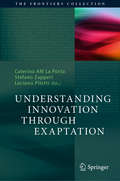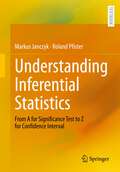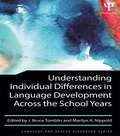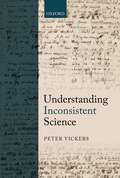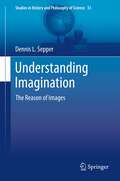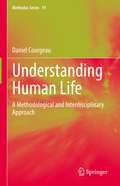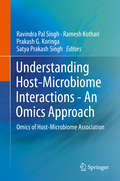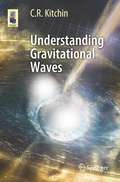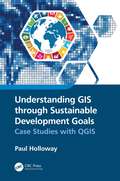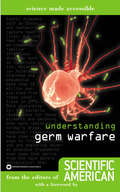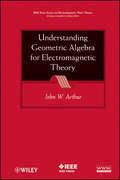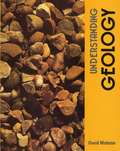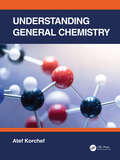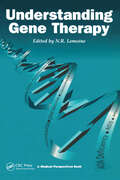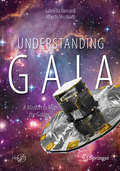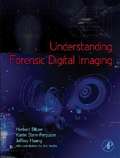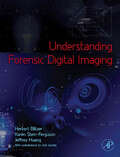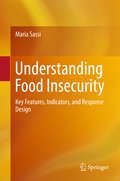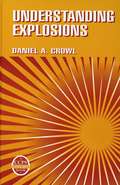- Table View
- List View
Understanding Innovation Through Exaptation (The Frontiers Collection)
by Caterina AM La Porta Stefano Zapperi Luciano PilottiThis book explores the role of exaptation in diverse areas of life, with examples ranging from biology to economics, social sciences and architecture. The concept of exaptation, introduced in evolutionary biology by Gould and Vrba in 1982, describes the possibility that already existing traits can be exploited for new purposes throughout the evolutionary process. Edited by three active scholars in the fields of biology, physics and economics, the book presents an interdisciplinary collection of expert viewpoints illustrating the importance of exaptation for interpreting current reality in various fields of investigation. Using the lenses of exaptation, the contributing authors show how to view the overall macroscopic landscape as comprising many disciplines, all working in unity within a single complex system. This book is the first to discuss exaptation in both hard and soft disciplines and highlights the role of this concept in understanding the birth of innovation by identifying key elements and ideas. It also offers a comprehensive guide to the emerging interdisciplinary field of exaptation, provides didactic explanations of the basic concepts, and avoids excessive jargon and heavy formalism. Its target audience includes graduate students in physics, biology, mathematics, economics, psychology and architecture; it will also appeal to established researchers in the humanities who wish to explore or enter this new science-driven interdisciplinary field.
Understanding Inferential Statistics: From A for Significance Test to Z for Confidence Interval
by Markus Janczyk Roland PfisterWhat does this p-value actually mean? And what is a significant result? This book provides a compact and comprehension-oriented introduction to inferential statistics and answers questions like these. One focus is on the logic underlying inferential statistics and hypothesis testing: Readers learn the most commonly used procedures (t-test, analysis of variance with and without repeated measures, correlation/regression) as well as the pitfalls of data analysis, and develop the understanding necessary to interpret results correctly. The individual chapters are supplemented by concrete evaluation examples from everyday research - including exemplary implementation with the programs SPSS and R. In addition to the classic methods, cross-references to current developments in psychological methodological research are also included.This book is a translation of the original German 3rd edition of Inferenzstatistik verstehen by Markus Janczyk and Roland Pfister. The translation was done with the help of artificial intelligence (machine translation by the service DeepL.com). A subsequent human revision was done primarily in terms of content, so that the book will read stylistically differently from a conventional translation.
Understanding Individual Differences in Language Development Across the School Years
by J. Bruce Tomblin Marilyn A. NippoldThis volume presents the findings of a large-scale study of individual differences in spoken (and heard) language development during the school years. The goal of the study was to investigate the degree to which language abilities at school entry were stable over time and influential in the child’s overall success in important aspects of development. The methodology was a longitudinal study of over 600 children in the US Midwest during a 10-year period. The language skills of these children -- along with reading, academic, and psychosocial outcomes -- were measured. There was intentional oversampling of children with poor language ability without being associated with other developmental or sensory disorders. Furthermore, these children could be sub-grouped based on their nonverbal abilities, such that one group represents children with specific language impairment (SLI), and the other group with nonspecific language impairment (NLI) represents poor language along with depressed nonverbal abilities. Throughout the book, the authors consider whether these distinctions are supported by evidence obtained in this study and which aspects of development are impacted by poor language ability. Data are provided that allow conclusions to be made regarding the level of risk associated with different degrees of poor language and whether this risk should be viewed as lying on a continuum. The volume will appeal to researchers and professionals with an interest in children’s language development, particularly those working with children who have a range of language impairments. This includes Speech and Language Pathologists; Child Neuropsychologists; Clinical Psychologists working in Education, as well as Psycholinguists and Developmental Psychologists.
Understanding Individual Differences in Language Development Across the School Years
by J. Bruce Tomblin Marilyn A. NippoldThis volume presents the findings of a large-scale study of individual differences in spoken (and heard) language development during the school years. The goal of the study was to investigate the degree to which language abilities at school entry were stable over time and influential in the child’s overall success in important aspects of development. The methodology was a longitudinal study of over 600 children in the US Midwest during a 10-year period. The language skills of these children -- along with reading, academic, and psychosocial outcomes -- were measured. There was intentional oversampling of children with poor language ability without being associated with other developmental or sensory disorders. Furthermore, these children could be sub-grouped based on their nonverbal abilities, such that one group represents children with specific language impairment (SLI), and the other group with nonspecific language impairment (NLI) represents poor language along with depressed nonverbal abilities. Throughout the book, the authors consider whether these distinctions are supported by evidence obtained in this study and which aspects of development are impacted by poor language ability. Data are provided that allow conclusions to be made regarding the level of risk associated with different degrees of poor language and whether this risk should be viewed as lying on a continuum. The volume will appeal to researchers and professionals with an interest in children’s language development, particularly those working with children who have a range of language impairments. This includes Speech and Language Pathologists; Child Neuropsychologists; Clinical Psychologists working in Education, as well as Psycholinguists and Developmental Psychologists.
Understanding Inconsistent Science
by Peter VickersIn recent years philosophers of science have urged that many scientific theories are extremely useful and successful despite being internally inconsistent. Via an investigation of eight alleged 'inconsistent theories' in the history of science, Peter Vickers urges that this view is at best overly simplistic. Most of these cases can only be described as examples of 'inconsistent science' if we employ reconstructions of science which depart from the real (history of) science to an unacceptable degree. And where we do find genuine inconsistency he argues that the nature of—and correct response to—the inconsistency differs dramatically depending on the details of the science in question. Thus we are warned against making overly general claims about 'science': what are all called 'theories' in the history of science are actually significantly different entities, which work in different ways and react to inconsistency in different ways. Vickers argues that the traditional goal of philosophy to make substantial, fully general claims about 'how science works' is misguided, and can be significantly circumvented if we re-frame our debates such that reference to 'theories' is eliminated. In this way one is not tempted to think of the history of science as a history of instances of the same kind—theory—about which one could hope to say something substantial and general. And in addition eliminating theory means that we avoid fruitless debates about the 'real' nature and content of 'theories'. Vickers' account leads to a particularist philosophy of science, where the reader is urged to appreciate the often dramatic differences between the different 'inconsistencies in science' which have been identified.
Understanding Imagination: The Reason of Images (Studies in History and Philosophy of Science #33)
by Dennis L SepperThis book discusses that imagination is as important to thinking and reasoning as it is to making and acting. By reexamining our philosophical and psychological heritage, it traces a framework, a conceptual topology, that underlies the most disparate theories: a framework that presents imagination as founded in the placement of appearances. It shows how this framework was progressively developed by thinkers like Plato, Aristotle, Descartes, and Kant, and how it is reflected in more recent developments in theorists as different as Peirce, Saussure, Wittgenstein, Benjamin, and Bachelard. The conceptual topology of imagination incorporates logic, mathematics, and science as well as production, play, and art. Recognizing this topology can move us past the confusions to a unifying view of imagination for the future.
Understanding Human Life: A Methodological and Interdisciplinary Approach (Methodos Series #19)
by Daniel CourgeauThis book addresses the challenge of understanding human life. It compares our life experience with the attempts to grasp it by astrologers, eugenicists, psychologists, neuroscientists, social scientists, and philosophers. The main opposition among these specialties lies between understanding and misunderstanding. The book also addresses the central methodological difficulty of capturing a human life. It is first examined how certain approaches may lead to a misunderstanding of human life. The book contrasts the example of astrology—an accepted practice in ancient civilizations, but now classified among the pseudosciences—with astronomy, a full-fledged science since Galileo’s time. Another, more recent approach regards human life as predetermined by genes: the methods used by eugenicists, and later by political regimes under the name of hereditarianism, came to compete with genetics. A broader analysis shows how astrology and eugenicism are not truly scientific approaches. Next, the book looks at the ways of capturing an imaginary or real human life story. A comprehensive approach will try to fully understand their complexity, while a more explanatory approach considers only certain specific phenomena of human life. For example, demography studies only births, deaths, and migration. Another crucial factor in the collection of life histories is memory and its transmission. Psychology and psychoanalysis have developed different schools to try to explain them. The book concludes with a detailed discussion of the concepts and tools that have been proposed in more recent times for understanding the various aspects of life stories: mechanisms, systems, hermeneutics, and autonomy.
Understanding Host-Microbiome Interactions - An Omics Approach: Omics of Host-Microbiome Association
by Ravindra Pal Singh Ramesh Kothari Prakash G. Koringa Satya Prakash SinghThis book offers up-to-date information on different microbiomes, their community composition and interactive functions with the host, bringing together information from diverse research reports to provide an overview of the rapid developments in meta-omics technologies. It is a valuable resource for scientists, researchers, postgraduate and graduate students interested in understanding the impact and importance of next generation sequencing technologies on different hosts and their microbiomes.
Understanding Gravitational Waves (Astronomers' Universe)
by C. R. KitchinThe birth of a completely new branch of observational astronomy is a rare and exciting occurrence. For a long time, our theories about gravitational waves—proposed by Albert Einstein and others more than a hundred years ago—could never be fully proven, since we lacked the proper technology to do it. That all changed when, on September 14, 2015, instruments at the LIGO Observatory detected gravitational waves for the first time. This book explores the nature of gravitational waves—what they are, where they come from, why they are so significant and why nobody could prove they existed before now. Written in plain language and interspersed with additional explanatory tutorials, it will appeal to lay readers, science enthusiasts, physical science students, amateur astronomers and to professional scientists and astronomers.
Understanding GIS through Sustainable Development Goals: Case Studies with QGIS
by Paul HollowayUnderstanding GIS through Sustainable Development Goals applies a pedagogical shift to learning GIS, as the readers employ the concepts and methodologies on real-world problems. This book provides 16 case studies across most of the Sustainable Development Goals (SDGs) with step-by-step practical instructions using QGIS(Quantum Geographic Information System) , an open-source software. It helps readers develop GIS skills on real-world data, while learning the fundamentals such as spatial data models, projections, and spatial databases, different cartographic methods, such as graduated symbology, change maps, and dynamic visualization, as well as more intermediate and advanced spatial analysis such as geoprocessing, multiple criteria analysis, and spatial statistics. The topics chosen are taught in secondary and tertiary education institutions which make this a textbook for all students and educators. Features: Focuses on learning GIS through 16 real world case studies. Introduces an open-source software that can be used beyond the classroom. Analyzes Sustainable Development Goals in a global framework and provides an alternative approach to learning GIS. Supports both secondary and tertiary educators and improves GIS education at all levels. Contains a holistic range of case studies that extend across several disciplines, from geography education, environmental sciences, geosciences, natural sciences, social sciences, and digital humanities. This is a textbook for all students and educators, providing 16 case studies across most of the SDGs with step-by-step practical instructions using QGIS, an open-source software.
Understanding GIS through Sustainable Development Goals: Case Studies with QGIS
by Paul HollowayUnderstanding GIS through Sustainable Development Goals applies a pedagogical shift to learning GIS, as the readers employ the concepts and methodologies on real-world problems. This book provides 16 case studies across most of the Sustainable Development Goals (SDGs) with step-by-step practical instructions using QGIS(Quantum Geographic Information System) , an open-source software. It helps readers develop GIS skills on real-world data, while learning the fundamentals such as spatial data models, projections, and spatial databases, different cartographic methods, such as graduated symbology, change maps, and dynamic visualization, as well as more intermediate and advanced spatial analysis such as geoprocessing, multiple criteria analysis, and spatial statistics. The topics chosen are taught in secondary and tertiary education institutions which make this a textbook for all students and educators. Features: Focuses on learning GIS through 16 real world case studies. Introduces an open-source software that can be used beyond the classroom. Analyzes Sustainable Development Goals in a global framework and provides an alternative approach to learning GIS. Supports both secondary and tertiary educators and improves GIS education at all levels. Contains a holistic range of case studies that extend across several disciplines, from geography education, environmental sciences, geosciences, natural sciences, social sciences, and digital humanities. This is a textbook for all students and educators, providing 16 case studies across most of the SDGs with step-by-step practical instructions using QGIS, an open-source software.
Understanding Germ Warfare
by Editors of Scientific AmericanWritten for the popular reader, this small volume contains short chapters on the science behind germ warfare. How diseases occur, the creation and use of vaccines, viral genomics, and resistance to antibiotics are some of the topics. Annotation copyrighted by Book News, Inc., Portland, OR
Understanding Geometric Algebra for Electromagnetic Theory (IEEE Press Series on Electromagnetic Wave Theory #38)
by John W. ArthurThis book aims to disseminate geometric algebra as a straightforward mathematical tool set for working with and understanding classical electromagnetic theory. It's target readership is anyone who has some knowledge of electromagnetic theory, predominantly ordinary scientists and engineers who use it in the course of their work, or postgraduate students and senior undergraduates who are seeking to broaden their knowledge and increase their understanding of the subject. It is assumed that the reader is not a mathematical specialist and is neither familiar with geometric algebra or its application to electromagnetic theory. The modern approach, geometric algebra, is the mathematical tool set we should all have started out with and once the reader has a grasp of the subject, he or she cannot fail to realize that traditional vector analysis is really awkward and even misleading by comparison. Professors can request a solutions manual by email: pressbooks@ieee.org
Understanding Geometric Algebra for Electromagnetic Theory (IEEE Press Series on Electromagnetic Wave Theory #38)
by John W. ArthurThis book aims to disseminate geometric algebra as a straightforward mathematical tool set for working with and understanding classical electromagnetic theory. It's target readership is anyone who has some knowledge of electromagnetic theory, predominantly ordinary scientists and engineers who use it in the course of their work, or postgraduate students and senior undergraduates who are seeking to broaden their knowledge and increase their understanding of the subject. It is assumed that the reader is not a mathematical specialist and is neither familiar with geometric algebra or its application to electromagnetic theory. The modern approach, geometric algebra, is the mathematical tool set we should all have started out with and once the reader has a grasp of the subject, he or she cannot fail to realize that traditional vector analysis is really awkward and even misleading by comparison. Professors can request a solutions manual by email: pressbooks@ieee.org
Understanding Geology (PDF)
by David WebsterThe carefully sequenced content ensures a logical build-up of key ideas, and cross-referencing between chapters enables pupils to integrate all aspects of the subject. Each chapter is broken into manageable short sections for ease of use, and ends with a set of data-response questions. The Fieldwork Appendix provides practical guidelines for preparing and conducting field-work, and there are ideas for practical work which link to each chapter.
Understanding General Chemistry
by Atef KorchefUnderstanding General Chemistry details the fundamentals of general chemistry through a wide range of topics, relating the structure of atoms and molecules to the properties of matter. Written in an easy-to-understand format with helpful pedagogy to fuel learning, the book features main objectives at the beginning of each chapter, get smart sections, and check your reading section at the end of each chapter. The text is filled with examples and practices that illustrate the concepts at hand. In addition, a summary, and extensive MCQs, exercises and problems with the corresponding answers and explanations are readily available. Additional features include: Alerts students to common mistakes and explains in simple ways and clear applications how to avoid these mistakes. Offers answers and comments alongside sample problems enabling students to self-evaluate their skill level. Includes powerful methods, easy steps, simple and accurate interpretations, and engaging applications to help students understand complex principles. Provides a bridge to more complex topics such as solid-state chemistry, organometallic chemistry, chemistry of main group elements, inorganic chemistry, and physical chemistry. This introductory textbook is ideal for chemistry courses for non-science majors as well as health sciences and preparatory engineering students.
Understanding General Chemistry
by Atef KorchefUnderstanding General Chemistry details the fundamentals of general chemistry through a wide range of topics, relating the structure of atoms and molecules to the properties of matter. Written in an easy-to-understand format with helpful pedagogy to fuel learning, the book features main objectives at the beginning of each chapter, get smart sections, and check your reading section at the end of each chapter. The text is filled with examples and practices that illustrate the concepts at hand. In addition, a summary, and extensive MCQs, exercises and problems with the corresponding answers and explanations are readily available. Additional features include: Alerts students to common mistakes and explains in simple ways and clear applications how to avoid these mistakes. Offers answers and comments alongside sample problems enabling students to self-evaluate their skill level. Includes powerful methods, easy steps, simple and accurate interpretations, and engaging applications to help students understand complex principles. Provides a bridge to more complex topics such as solid-state chemistry, organometallic chemistry, chemistry of main group elements, inorganic chemistry, and physical chemistry. This introductory textbook is ideal for chemistry courses for non-science majors as well as health sciences and preparatory engineering students.
Understanding Gene Therapy
by Prof Nick LemoineThis title explains what gene therapy is, how genes are delivered and how they are targeted. It discusses recent gene therapy trials, future applications and considers the ethical and safety issues surrounding gene therapy. Understanding Gene Therapy is a
Understanding Gene Therapy
by Prof Nick LemoineThis title explains what gene therapy is, how genes are delivered and how they are targeted. It discusses recent gene therapy trials, future applications and considers the ethical and safety issues surrounding gene therapy. Understanding Gene Therapy is a
Understanding Gaia: A Mission to Map the Galaxy (Springer Praxis Books)
by Gabriella Bernardi Alberto VecchiatoThis book is the first to provide a comprehensive, readily understandable report on the European Space Agency’s Gaia mission that will meet the needs of a general audience. It takes the reader on an exciting journey of discovery, explaining how such a scientific satellite is made, presenting the scientific results available from Gaia to date, and examining how the collected data will be used and their likely scientific consequences. The Gaia mission will provide a complete and high-precision map of the positions, distances, and motions of the stars in our galaxy. It will revolutionize our knowledge on the origin and evolution of the Milky Way, on the effects of mysterious dark matter, and on the birth and evolution of stars and extrasolar planets. The Gaia satellite was launched in December 2013 and has a foreseen operational lifetime of five to six years, culminating in a final stellar catalogue in the early 2020s. This book will appeal to all who have an interest in the mission and the profound impact that it will have on astronomy.
Understanding Forensic Digital Imaging (PDF)
by Herbert L. Blitzer Karen Stein-Ferguson Jeffrey HuangUnderstanding Forensic Digital Imaging offers the principles of forensic digital imaging and photography in a manner that is straightforward and easy to digest for the professional and student. It provides information on how to photograph any setting that may have forensic value, details how to follow practices that are acceptable in court, and recommends what variety of hardware and software are most valuable to a practitioner. In addition to chapters on basic topics such as light and lenses, resolution, and file formats, the book contains forensic-science-specific information on SWGIT and the use of photography in investigations and in court. Of particular note is Chapter 17, Establishing Quality Requirements, which offers information on how to create a good digital image, and is more comprehensive than any other source currently available. Covers topics that are of vital importance to the practicing professional Serves as an up-to-date reference in the rapidly evolving world of digital imaging Uses clear and concise language so that any reader can understand the technology and science behind digital imaging
Understanding Forensic Digital Imaging
by Herbert L. Blitzer Karen Stein-Ferguson Jeffrey HuangUnderstanding Forensic Digital Imaging offers the principles of forensic digital imaging and photography in a manner that is straightforward and easy to digest for the professional and student. It provides information on how to photograph any setting that may have forensic value, details how to follow practices that are acceptable in court, and recommends what variety of hardware and software are most valuable to a practitioner. In addition to chapters on basic topics such as light and lenses, resolution, and file formats, the book contains forensic-science-specific information on SWGIT and the use of photography in investigations and in court. Of particular note is Chapter 17, Establishing Quality Requirements, which offers information on how to create a good digital image, and is more comprehensive than any other source currently available.Covers topics that are of vital importance to the practicing professionalServes as an up-to-date reference in the rapidly evolving world of digital imagingUses clear and concise language so that any reader can understand the technology and science behind digital imaging
Understanding Food Insecurity: Key Features, Indicators, and Response Design
by Maria SassiThis book provides a comprehensive overview of key aspects of food insecurity, including definitional and conceptual issues, information systems and data sources, indicators, and policies. The aim is to equip readers with a sound understanding of the subject that will assist in the recognition of food insecurity and the design of suitable responses. The early chapters discuss the evolution and limitations of the concept and provide a set of conceptual frameworks for the analysis of food security. Systems used to collect data and their evolution over time are then explained, and the most commonly adopted indicators for monitoring food security are presented. Approaches to food security are then thoroughly reviewed decade by decade. Specific attention is paid to the food insecurity challenge in the new millennium, focusing particularly on recent food crises and institutional and policy-related consequences. Finally, the specific terminology of food aid and assistance is examined, with discussion of the instruments recently adopted in the food aid system. This book will be an informative and stimulating resource for both students and professionals.
Understanding Fluorescein Angiography, Fluoreszeinangiografie verstehen, Entendiendo Angiografía con Fluoresceína
by Manfred SpitznasFluorescein angiography is an indispensable tool in ophthalmology. It is founded on the evaluation of phenomena related to the behavior intravenously administered sodium fluorescein in the tissues of the ocular fundus. This book deals with the morphological prerequisites and structural changes on which the individual phenomena are based. It provides the retina specialist, the general ophthalmologist, and the basic scientist with valuable information toward understanding the nature and mechanism of the underlying disorders.
Understanding Explosions (A CCPS Concept Book #16)
by Daniel A. CrowlThere are many different types of explosions, each with its own complex mechanism. Understanding explosions is important in preventing them. This reference provides valuable information on explosions for everyone involved in the operation, design, maintenance, and management of chemical processes, helping enhance understanding of the nature of explosions and the practical methods required to prevent them from occurring. The text includes: Fundamental basis for explosions Explosive and flammable behavior and characteristics of materials Different types of explosions Fire and explosion hazard recognition Practical methods for preventing explosions or minimizing the potential consequences Additional references Understanding Explosions provides a practical understanding of explosion fundamentals, including the different types of explosions, the explosive and flammable behavior of materials, and the hazards related to fires and explosions. It also discusses practical methods to prevent and minimize the probability and consequence of an explosion during routine use of flammable, combustible and/or reactive materials.
